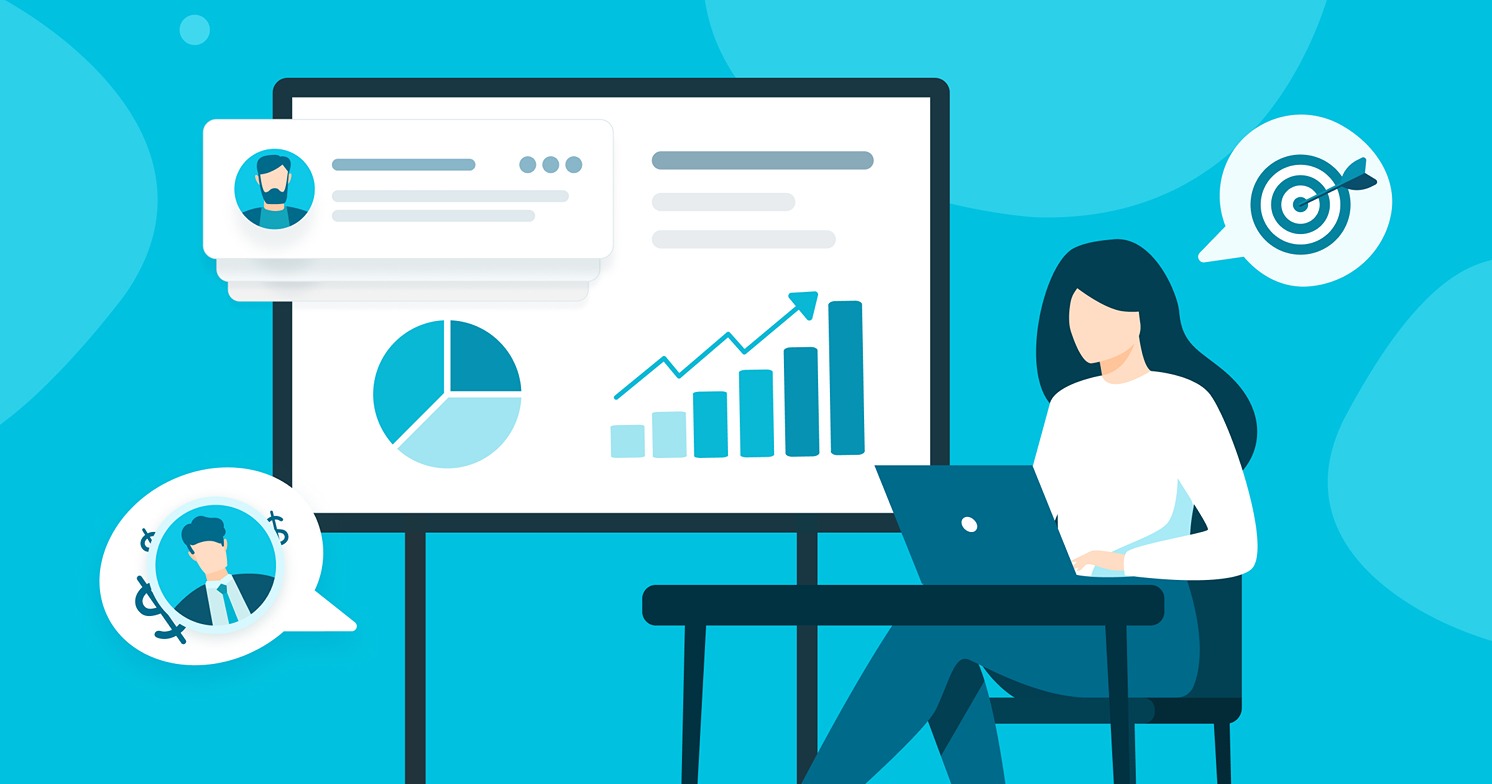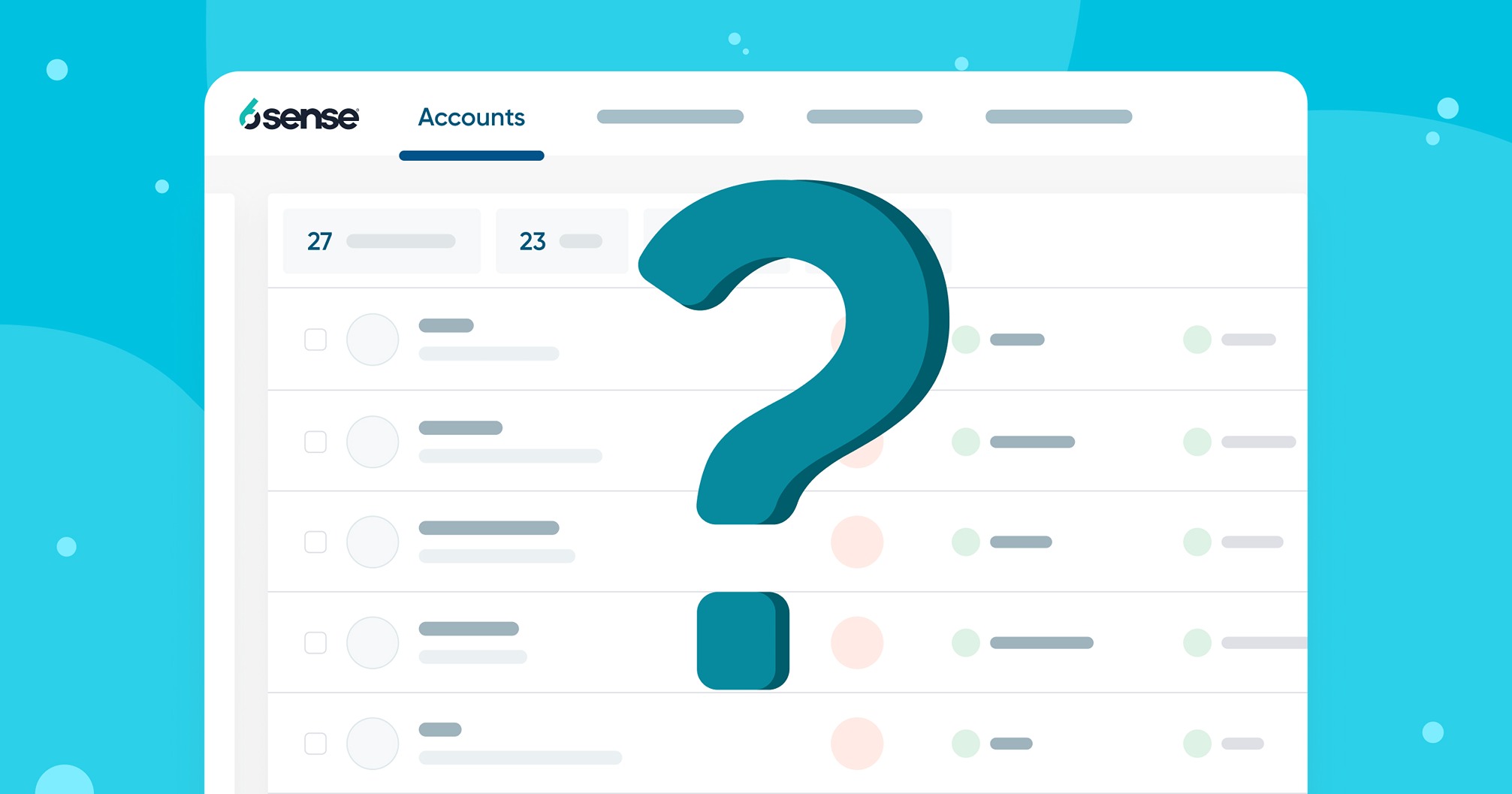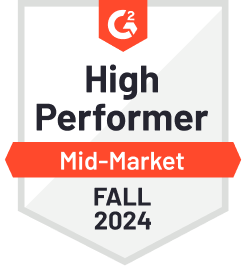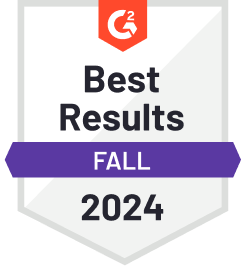As economic volatility and digital disruption remake the B2B sales landscape, staying ahead of the latest trends and benchmarks is crucial for informing strategy. This report synthesizes over 150 authoritative sales statistics across essential categories like achievement, process, and technology to reveal the factors driving success today. From investments paying off to gaps requiring attention, the data offers unrivaled clarity for leaders aiming to sharpen execution.
Though uncertainty persists in 2024, strategic alignment to critical drivers of revenue generation, deal velocity, and rep performance allows dynamic organizations to turn obstacles into opportunities.
General B2B Sales Statistics
Keeping pace with the latest overarching sales trends is key amidst economic shifts. The following statistics highlight moderating budgets, the rise of digital, and data challenges impacting productivity.
- In 2023, B2B marketing data spending was projected to reach $3.74 billion, representing a 2.3% year-over-year increase, according to Insider Intelligence.
- B2B e-commerce expanded by 17% in 2023, evidencing the continued acceleration of digital channels in B2B sales, according to Digital Commerce 360.
As more B2B buyers shift purchases online, having an optimized ecommerce experience is now table stakes.
- The average website conversion rate across industries is 2.9%, but B2B e-commerce exhibits some of the highest conversion rates analyzed, per data from Ruler Analytics.
This differential highlights the importance of website optimization and lead nurturing for B2B sellers operating online stores.
- Private companies with $5-20 million in ARR saw the most significant decrease in median year-over-year revenue growth, dropping 26 percentage points from 61% in 2022 to 35% in 2023, according to Paddle’s 2023 B2B SaaS Market Report.
For context, larger companies with $20-50 million ARR declined from 40% to 24% over the same period.
- The Gartner Future of Sales 2025 report predicts that 80% of B2B sales interactions will occur in digital channels by 2025.
As buyers continue shifting online, having an optimized digital sales strategy is becoming non-negotiable.
- Reflecting data challenges, 45% of selling professionals say incomplete data is their biggest obstacle.
This highlights the growing need for sales technologies that consolidate relevant CRM, marketing, and customer data.
- 99% of B2B purchases are driven by organizational changes like digital transformations or operational shifts, and 66% of B2B buyers say the amount of change in their organization is overwhelming, according to Gartner.
This shows that aligning your sales messaging to crucial business initiatives taking place in prospective companies can boost relevance.
- Sales reps spend just 28% of their week actually selling, per Salesforce’s State of Sales report.
With the majority of time getting lost in admin tasks, equipping reps with automated sales pipeline tools to eliminate friction is critical.
- Just over 2 in 5 B2B marketing leaders say they have a “somewhat good” understanding of generative AI marketing tools useful for campaigns, while less than 1 in 5 claim an “extremely good” understanding, according to LinkedIn.
This presents an opportunity for forward-thinking B2B marketers to upskill in leveraging AI.
- Research suggests only 5% of potential buyers are actively in-market, but the remaining 95% may consider a purchase decision later, per a Demand Gen Report.
This highlights the importance of nurturing initiatives to stay top-of-mind.
B2B Sales Teams Statistics
Developing an empowered sales org sitting on strong foundations drives deal velocity. Key statistics showcase hiring obstacles, objection-handling capabilities tied to achievement, and the impact of trusting cultures on sales success.
- Hiring solid sales talent, selling in an uncertain economy, and generating sales-ready leads are identified as the top challenges faced by B2B sales managers and leaders.
With economic headwinds persisting into 2023, overcoming these obstacles will be essential for sales teams looking to hit targets.
- Top-performing sales reps are 843% more likely to overcome common objections effectively compared to average performers
Mastering objection-handling skills through regular training and coaching can thus provide a major competitive advantage.
- 24% of high-performing sales teams rank building a culture of trust as highly important, whereas only 13% of underperforming teams do the same.
This indicates that fostering psychological safety and strong relationships amongst team members translates into better sales results.
- 84% of professionals across sales titles believe that a strong sales team culture positively impacts their company’s performance.
This demonstrates that building an engaging and supportive environment for reps delivers tangible business results beyond revenue targets.
- Sales team members who feel like a cog in the machine are .66x as likely to attain quota goals per Gartner analysis.
Making your B2B sales rep team feel valued and heard through transparency and feedback loops is thus integral for motivation.
- When examining B2B sales coverage ratios, 90% of respondents in a Glencoco survey have at least 1 SDR supporting each Account Executive.
This shows consensus around a 1:1 SDR: AE structure optimal for dividing B2B prospecting and closing duties.
- 66% of very successful content marketers have more than four specialists on their team, whereas only 32% of unsuccessful content marketers have the same staffing bandwidth, according to SEMrush.
This large differential highlights the importance of adequately resourcing content production for B2B lead generation.
- Looking at B2B sales coaching, the average number of manager-led coaching sessions per month is 3. For top-performing reps, this average jumps to 11 sessions.
More frequent one-on-ones thus directly translate into higher achievement.
- There is often a disconnect between managers and reps regarding coaching perception. 81% of sales reps say they get valuable coaching from their boss, while only 75% of managers believe the same, according to Salesforce.
Tightening this perception gap can strengthen sales or business development programs.
- Top sales reps are 588% more likely to follow methodology effectively compared to peers based on benchmarks.
Instilling disciplined sales processes through training and reinforcement is key.
B2B Sales Process Statistics
Granular sales workflow improvements compound to substantially impact achievement. Statistics underline the importance of boosting process efficiency, shortening onboarding, and equipping sellers to navigate complex decision journeys.
- 43% of B2B sales leaders reported an increase in sales cycle length over the past 12 months, while 16% saw a decrease and 41% observed no change.
With almost half seeing slowing deal velocity, refining qualification and nurturing processes to accelerate opportunities will be critical.
- According to McKinsey analysis, over 30% of B2B customers already use digital self-serve channels for purchase experiences and over 77% are willing to spend up to $50K online.
Customer openness to digital transactions presents a significant opportunity to reduce sales friction.
- Sales reps spend just 2 hours per day actively selling.
This indicates substantial time lost on non-sales tasks, highlighting a need to optimize processes and technology stacks to maximize selling time.
- 29% of sales professionals rank making their whole sales process more efficient as a top goal for 2023.
With competition and uncertainty persisting, optimizing productivity will remain mission-critical.
- 40% of sales teams face long onboarding times that bog down deal velocity.
Shortening ramp-up through targeted new hire enablement can help accelerate sales cycles.
- 72% of respondents have seen B2B customer journeys become more complex over the past year compared to 65% in 2022.
As decisions involve more stakeholders and touchpoints, equipping reps with materials to guide prospects is essential.
- 71% of B2B buyers downloaded and consumed multiple assets to inform decisions over the past year, and 46% increased consumption volumes.
- Most buyers completed purchases within six months, and only 14% of $1M+ deals took over a year.
Developing rich, staggered content across the buyer journey is thus crucial.
- 47% of B2B companies have 3-5 decision-makers on buying teams.
Mapping all stakeholders early on allows for the targeting of personalized messaging.
- 78% of salespeople juggle 1-40 prospects at once according to HubSpot research.
B2B Sales Technology Statistics
Advancements in sales tech promise productivity gains, but change management and smart consolidation remain fundamental to prevent overwhelm.
- 61% of marketers said their organization either hasn’t acquired the right technology – or has the technology but isn’t using it to potential, according to the Content Marketing Institute.
This highlights a major gap in maximizing sales tech tools that can streamline the buying process and provide data-driven insights when leveraged effectively.
- 45% of sales pros are overwhelmed by the number of tools in their tech stack, according to HubSpot.
Consolidating platforms with integrated solutions can help simplify workflows for B2B sales teams facing tech overload.
- According to LinkedIn’s Deep Sales Playbook, 39% of sellers are using AI to create efficiencies in their sales process.
As AI adoption gains momentum, ensuring SDR teams undergo proper change management and training will be vital to realizing the full benefits.
- High-performing sellers are 4.1x more likely than others to utilize sales intelligence tools to identify areas of opportunities across accounts.
Leveraging B2B data providers and tech to uncover customer needs can significantly boost deal sizes.
- 60% of sales leaders are planning to invest in prospecting technology.
The adoption of specialized outreach tools continues to rise as teams aim to increase productivity.
- 73% of sales leaders believe sales and revenue technologies are empowering sellers.
However, change management remains vital to ensure user adoption and impact.
- Over 30% of sales teams list performance and reliability as a top factor when evaluating sales tools for their organization.
As teams rely on tech to drive productivity, stable and fast platforms are non-negotiable.
- Over 60% of respondents in a Seismic study cited resistance to adopting new tools due to cultural issues as a factor for why previous sales tools failed to meet expectations.
Getting stakeholder buy-in early on is thus vital for change management success.
- With over half of enterprises planning to grow their tech spending, the 2024 B2B tech market outlook represents a healthy three percentage point increase from 2023, even adjusting for inflation, according to McKinsey research.
- McKinsey projects B2B tech will expand by about $150 billion across surveyed regions, representing 8.5% growth to reach $1.9 trillion in annual revenue.
Capturing share in this growing market hinges on sales execution.
B2B Sales Calls Statistics
Despite the digital disruption, phone conversations retain unmatched power for active selling, relationship building, and closing deals. These cold calling statistics highlight the ins and outs of this channel.
- 44% of survey respondents ranked phone calls as the most effective way to close deals.
Even with the rise of digital channels, verbal communication remains critical for building rapport and addressing buyer concerns.
- 62% of respondents say they’ve increased calling volume in the last 12 months, per Glencoco.
- 58% of sales leaders say the pipeline generated from calling has increased in the last 12 months.
Combining offline and online tactics produces a powerful omni-channel motion.
- The average customer talk time in the discovery stages is 39%, a significant decrease from 51% last year, according to MindTickle.
Letting prospects speak more by asking good questions is critical for understanding needs.
- Gong data shows a 2.1x higher success rate for salespeople who state their reason for calling during a cold call.
Clearly conveying value upfront improves engagement.
- Successful cold calls have over twice the average monologue duration at 53 seconds, compared to just 25 seconds for unsuccessful ones.
- 29% of working professionals report their top use for voice calls is closing sales, according to Hiya.
Phone conversations remain indispensable for negotiating deals and overcoming objections.
- 42% of workers say they have lost customers or potential deals due to their inability to connect by phone.
With unreachable prospects, significant revenue is left on the table.
- 8% of intent-based warm calls resulted in a booked sales meeting, according to Sopro.
- Analyzing 11 million outbound calls PhoneBurner found the most productive cold calling time is 10 AM, when 15.53% of calls are answered and spark business conversations.
Optimizing cadence to target audience engagement peaks lifts results.
B2B Sales Emails Statistics
Email continues providing unmatched ROI, but tighter privacy regulations and crowded inboxes now mandate more targeted, personalized communication.
- Over half of buyers (57%) said that email is their preferred mode for the first touch, but 78% also overwhelmingly agree that introductions should be personalized to them and their business, according to LinkedIn.
Making outreach relevant from the start drives connections.
- One in three marketers reports using email, and 87% plan to maintain or increase their email marketing investment in 2024, per HubSpot.
Email’s consistently high performance cements its place in the martech stack.
- Analysts expect the number of email users to grow by 2.5% annually until hitting 4.73 billion globally in 2025.
- According to Marketo’s proprietary engagement score, which tracks email effectiveness, 23% of email engagement can be explained by segmentation.
More personalized, targeted sends yield higher responses.
- Sales and marketing teams lose up to 25% of email subscribers annually due to attrition, and engaged subscribers don’t always convert.
- The IT and services industry sees the highest email open rate at 39.5%, followed by insurance at 30.36%, according to data from Belkins.
Optimizing subject lines and sender profiles by sector can improve performance.
- 67% of buyers prefer to be contacted via email over any other channel.
Email thus remains a top driver of sales opportunities. However, marketers must still ensure they gain consent and provide value to avoid becoming promotional.
- 57% of companies rate their email personalization as just “basic” or “intermediate,” only using names.
More advanced segmentation and dynamic content lift results. Specifically, personas and lifecycle stage messaging lead to more relevant communications.
- Over 80% of marketers saw improved performance from subject line personalization, real-time content, and personalization with dynamic content.
These tactics should be best practices. Testing different approaches allows for determining optimal sales strategies.
- The ROI on email marketing is $36 for every $1 spent, according to the 2023 Litmus State of Email report.
Given the substantial uplift potential, investment is clearly justified. Specifically, budgeting for quality design, copy, and analytics tools pays dividends.
B2B Sales Success Statistics
Various factors, from content and events to data and coaching, influence B2B sales achievement on an individual and organizational level.
- One in 5 B2B buyers are actively in buying mode at any time, while the other 80% continue engaging with content to gather information, boost knowledge, gain sales skills, or participate in communities.
This highlights the importance of developing a robust content engine and community platform to nurture the majority of prospects who are not quite sales-ready.
- 91% of B2B sales pros engage in upselling, bringing in an average of 21% of company revenue.
- While 87% of B2B sellers believe meeting prospects in person before closing deals is critical, 67% of buyers agree.
In-person events must, therefore, focus on facilitating organic networking versus overt selling.
- Only 33% of sales reps consistently hit their targets.
Managers must invest in ongoing training, coaching, and data-driven insights to improve results to guide rep performance. Specifically, leveraging revenue enablement platforms and best practice sharing between top performers can lift achievement.
- Six in 10 B2B sales leaders believe having dedicated sales enablement support is ‘very’ or ‘extremely’ important for driving revenue per Aircall’s analysis.
However, proving enablement’s ROI remains an obstacle in many organizations. Aligning enablement initiatives to clear business KPIs is essential for securing executive buy-in and investment.
- 24% of sales professionals do not manage to log reliable and consistent meeting data or insights in their CRM, according to a Prezentor study.
This severely impacts forecasting and pipeline visibility. Better adoption incentives and training are required, in addition to evaluating the CRM itself if it’s proving cumbersome to use.
- 75% of organizations agree they have the processes, procedures, and metrics in place to measure B2B sales enablement impact, a rise from 69% in 2022.
However, qualitative feedback should supplement quantitative data to understand engagement and adoption challenges fully.
- 79% of marketing leads never convert into sales, commonly due to a lack of lead nurturing, according to Adobe.
Developing tailored nurture streams based on profile and behavior data is essential for steering leads sales-ready.
- Only 32% of respondents in a survey indicated satisfaction with their lead quality.
Lead scoring models should integrate both first-party and intent data signals to qualify accounts better.
- 55% of B2B sales reps said no-shows were the top reason for not closing deals.
B2B Sales Training Statistics
As economic landscapes continuously evolve, continually upskilling sales teams through the latest modalities proves integral for motivating and retaining top talent.
- 30% of sales leaders struggle to keep their sellers educated.
- 82% of sales team leaders believe enablement content or delivery must significantly evolve within five years to meet revenue goals per Gartner.
Personalization based on rep strengths and weaknesses will be crucial to optimization.
- 77% of leadership teams see sales operations and enablement as vital for driving sales performance.
However, proving enablement’s direct revenue impact remains an obstacle. Clear ROI attribution is essential for continued backing.
- The majority of organizations (76%) have formal training programs to upskill teams as sales skills must adapt to market and product changes.
However, only 27% feel their current training strategy is very effective. Evaluating new modalities like microlearning is vital.
- 77% of sales leaders agree personalized training correlates directly with positive sales performance.
- The average time to launch a new sales enablement program is 3-4 weeks.
While speed is important, ensuring executive sponsorship, effective sales management, and technical integrations are in place drives adoption.
- Six in 10 sales leaders believe dedicated sales enablement support is ‘very’ or ‘extremely’ important for revenue generation, according to HubSpot.
However, proving enablement’s direct ROI remains an obstacle for many organizations.
- Businesses investing in sales training see 50% higher net sales per employee per Training Industry research.
Ongoing skill development is thus integral for motivation and retention.
- Organizations with dedicated enablement efforts report a nine percentage point higher win rate versus those with no enablement.
This quantifies the tangible upside of resourcing enablement teams.
- 27% of companies have 6-10 enablement staff members, and 45% have 2-5 people.
B2B Sales Budget Statistics
Volatility requires agility in optimizing budgets across goals, teams, and programs to sustain performance.
- Use of paid content distribution decreased from 81% to 67% between 2022 and 2023, according to CMI research.
This indicates a shift from top-of-funnel activities towards mid-funnel lead gen as companies tighten budgets in a rocky economy. However, an integrated strategy across the sales funnel is ideal.
- Gartner found B2B marketing budgets decreased from 11% to 6.4% of revenue since 2020.
Economic uncertainty has led to tighter spending control. Demonstrating campaign ROI is now essential to secure funding.
- 70% of sales teams had budgets more heavily scrutinized in 2023 versus 2022.
With volatile conditions, managers must optimize tech stacks and processes for efficiency. Outlining rep-level achievement per dollar spent also brings clarity.
- Despite uncertainty, 76% of sellers and 64% of buyers expect budgets to increase by 1-24% in 2024.
Seller optimism likely stems from deal momentum while conservative buyers await stability.
- B2B marketers align budgets with revenue drivers – over 50% anticipate budget increases for social media and content marketing per Wpromote.
- Just 7% indicated an overall budget decrease in 2022, but almost one-third (32%) reported a 2023 budget decline, according to a Demand Gen Report.
Conversely, 24% maintained 2022’s 72% funding increase. Volatility requires agility in spending and testing.
- Companies with $10-25M in revenue allocate 72.4% of their budgets to marketing, while those with $25-100M allocate 59.5%.
Sub $10M companies invest 62.3%. Mid-market firms dedicate the most to the given sales team scale.
- 27% of sales and marketing teams have sub $1,000 monthly content marketing budgets per SEMrush.
- 85% of sales leaders indicate getting a budget for a needed headcount is very or somewhat challenging, according to Salesforce.
Leadership must, therefore, present clear ROI cases for rep productivity benefits to secure talent funding approvals.
- 38% of brands are increasing email budgets, while just 10% expect cutbacks.
B2B Sales Strategy Statistics
An array of trends showcases that while foundational sales skills remain vital, success increasingly depends on utilizing sales technology, data, and insights to optimize actions.
- Top-performing reps prioritize high-value accounts and personas when prospecting to use time effectively – the best personas saw +488% deal velocity improvement, and high-intent accounts closed 3.4x faster, according to EBsta.
- 52% of sales pros use sales enablement content, and 79% say it’s important for closing deals.
However, only 27% have a documented strategy for content usage. Mapping assets to each buying stage is critical.
- 86% of B2B buyers want full pricing transparency upfront, and 82% say actively engaging post-sale to deliver full solution value best builds trust.
Meeting these expectations requires organizational alignment between sales, marketing, and customer success.
- 82% agree better data leads to better marketing efforts, according to Demand Science.
However, only 29% say their data is very accurate. Centralizing CRM, MAP, and intent signals provide a unified view.
- Over half of sales leaders (52%) say misaligned B2B sales and marketing teams have cost revenue, and over one-third (36%) say it prevents joint success.
- 48% of sales professionals cite the inability to communicate value as their primary sales organization pain point.
Enablement providing approved messaging, battle cards, and objection handling training helps structure convincing narratives.
- According to Gartner, 83% of B2B sales leaders say their sellers struggle to adapt messaging to changing buyer needs.
Equipping reps with the latest competitive intel and value narratives is essential.
- 45% cite better sales and marketing alignment on go-to-market as their top 2023 demand gen priority.
- 48% of sales professionals leverage intent data to assess prospects researching purchases.
Integrating signals into workflows qualifies out low-potential targets.
- Just 22% of B2B sales representatives rate their content marketing strategy as advanced per a SEMrush study.
Developing persona-driven content mapped to each buying stage journey lifts performance.
B2B Sales Follow Up Statistics
Mastering the art of relevant, persistent, and personalized follow-up secures meetings, nurtures leads, and ultimately converts prospects into customers.
- 96% of prospects conduct independent research before engaging with sellers according to HubSpot.
- 64% of B2B sales pros provide self-service buying tools, and 85% say it’s an effective sales strategy.
However, only 19% say reps reference these portals often in prospect conversations. Training usage is vital.
- Deep sellers seek prospect feedback 89% of the time compared to just 53% for ineffective sellers.
This two-way dialogue builds trust and refines seller messaging to be relevant.
- Respondents say it takes 7+ touchpoints to land a prospect meeting, while Sales VPs and Directors estimate 10-15 are needed.
As senior execs are more challenging to reach, persistent and personalized outreach works.
- Nurtured leads make 47% larger purchases than non-nurtured leads per Adobe analysis.
Developing tailored, multi-touch nurture tracks specific to persona and profile is thus integral.
- 54% of professionals struggle to keep leads engaged after entering the B2B marketing funnel, per Ironpaper research.
Leveraging intent data to deliver hyper-relevant content prevents disengagement.
- 28% of sales pros cite lengthy sales cycles as the top reason prospects back out of deals.
Streamlining internal processes through SLAs prevents friction and churn.
- 69% agree reps know how to navigate different sales scenarios per Highspot.
Enablement equipping sellers with approved playbooks and objection handles drives preparedness
- 60% of customers say “no” four times before saying “yes,” according to InvespCRO.
- 35-50% of deals go to the sales professional who responds first.
B2B Social Selling Statistics
Social media continues to mature as a vital sales channel thanks to unparalleled relationship-building capabilities and intent signals that guide strategy.
- 60% of B2B content marketers rate LinkedIn as extremely or very effective – the highest of any platform per CMI.
Meanwhile, just 37% find Facebook effective, given its business focus. Tailoring personal content by channel is key.
- According to a Hubspot study, 82% of sales pros say building relationships and connecting with people is most important for sales.
Mapping out all players in purchasing decisions via social networks and conversations enables this.
- 64% of top sellers use social networks to identify decision-makers and 62% to uncover influencers.
Encouraging CRM logging of all stakeholder details helps teams engage buying groups.
- 60% name social as the top marketing channel for 2023 versus 50% in 2022, according to Wpromote.
- In 2024, 14% of marketers want to try social media selling.
Platforms like Instagram, LinkedIn, and TikTok enable authentic brand interaction at scale.
- 55% of marketers create more content and post more often to boost social ranking, while 53% aim to improve content quality.
- 52% of sales leaders prioritize social media and community building budget-wise.
User-generated and employee advocacy content drives authenticity.
- 65% of B2B marketing leaders expect increased LinkedIn usage in 2023.
Tailored content leveraging groups and pages to engage professional audiences.
- Highly targeted paid social ads see a 211% increase in direct leads and a 53% lift in deals signed.
Aligning to buyer persona and intent signals optimizes spend.
- 60% of US B2B marketers named social media their top revenue channel in 2023.
B2B Inbound Sales Statistics
Inbound channels like SEO, content, and marketing qualified leads continue driving substantial achievement – when optimized based on persona, stage, and sales readiness.
- 49% of sales and marketing teams listed SEO as a top marketing tactic implemented in 2023. However, only 28% have a fully documented SEO strategy.
Mapping organic campaigns to priority keywords and topics helps gain visibility.
- Organic inbound is the best-performing source for 500+ employee companies, boasting high win rates and 2x faster velocity.
- 43% of sales pros need higher quality leads from marketing — yet only 59% call current leads high quality.
Aligning an ideal lead definition and nurture criteria helps set expectations.
- 77% of marketers say generative AI helps create more personalized content.
Leveraging genAI tech for mass customization at scale boosts nurturing and ad relevance.
- 95% of B2B buying decisions are directly influenced by content.
Mapping informational assets to each targeted persona and buying stage is thus essential.
- 16% of marketers attribute the highest 2023 ROI to website, blog, and SEO efforts.
- 59% of sales professionals attribute revenue growth to marketing-sourced leads.
This quantifies content marketing’s substantial impact. Specifically, it highlights the need for sales and marketing alignment on what constitutes a qualified, sales-ready lead.
- 79% of very successful digital marketing teams spend over 10% of their budgets on content.
Given deals directly correlate, funding quality production is prudent. However, content must address targeted buyer pain points and integrate with the broader customer journey.
- 90% of sales and marketing teams have a content strategy, and 66% document it, up from 57% in 2022.
While progress has been made, 34% still lack frameworks to optimize effectiveness. Content mapping to personas and stages provides the structure needed.
- 54% of buyers are overwhelmed by available content, but quality is often lacking.
Tailoring to personas and stages thus breaks through noise. Content should further be coordinated across channels and teams to minimize fragmented experiences.
B2B Outbound Sales Statistics
Blending digital promotion with offline direct mail and events captures buyers through orchestrated brand interactions anchored around value.
- 48% of marketers said in-person events produced the best content marketing results over the past year, according to CMI.
Direct engagement builds relationships and gathers feedback to refine messaging. However, scaling events has associated costs and logistics.
- Outbound is the best-performing source for sub-500 employee companies, with 3x greater average deal values than inbound.
Proactive prospecting allows smaller firms to punch above their weight. Tactics must align to targeted personas and accounts, though.
- 63% of salespeople cite generating leads and prospecting as their biggest challenges.
Lead gen alignment across sales and marketing is thus critical for providing a top-of-funnel solid foundation.
- According to Demand Science, 73% of marketers desire more granular targeting options.
While broad-based tactics build awareness, personalized plays drive conversion and retention. Blending attributes like firmographics, tech stacks, and intent signals enables precision.
- All 11 industries surveyed in a study place phone calling in their top 3 outbound channels.
Direct conversations build rapport most effectively at pre- and post-digital touchpoints. Training reps on objection handling and value communication is key.
- 16% of marketers plan to debut experiential marketing using real-life pop-ups and events, plus influencer collaborations, according to HubSpot.
Both tactics enable authentic B2B list building around products. Measuring impact and scale remain challenges, though.
- 38% of sales teams are allocating budget to increase in-person events and tradeshow presence per a Demand Gen Report.
- Email-only outreach campaign lead rates fell 22.2% year-over-year.
This highlights the need to blend digital with traditional channels using orchestrated touches to break through.
- Buyers receiving personalized letters were 23% more likely to open subsequent emails.
- According to a Belkins study, 80% of sales and marketing teams use outbound marketing to explore new target segments.
Testing new personas and ICPs reveals expansion opportunities. Campaign success depends on relevance, though.
B2B Sales Metric Statistics
Despite economic turmoil impacting win rates and cycle velocity, finer measurement coupled with superior value propositions regains deal momentum.
- 81% of organizations now measure content performance, a rise from 75% the previous year.
While there is progress on quantifying impact, only 42% say their approach is very effective. Optimizing criteria like engagement, conversion, and revenue contribution is vital.
- The probability of selling to an existing customer is 70% versus just 5-20% for new prospects.
This vast difference highlights that retaining and growing accounts requires dedicated nurturing.
- As budgets tightened in 2023, B2B win rates declined 18% year-over-year and 27% versus 2021, according to EBsta benchmarks.
Economic challenges have increased scrutiny and stalled deals. Demonstrating superior value versus competitors can regain momentum.
- Despite a strong 2023 start, 73% of reps missed H2 quotas; now, in 2024, 69% are still falling short on average.
Economic uncertainty has impacted B2B conversion rates. Providing reps with competitive positioning and value-selling training can differentiate offerings.
- In 2023, the average B2B sales win rate is just 21% per HubSpot research.
With 4 out of 5 opportunities lost, perfecting qualification processes via data-backed ICPs and ideal customer profiles is mandatory to boost productivity.
- 54% of sales professionals saw customer acquisition costs increase over the past year.
With efficiency crucial in downturns, consolidating martech and sales tech stacks realizes more value from tools expenditure.
- 43% of sales calls now express more positive versus negative sentiments, a slight rise from 37% in 2022 per MindTickle.
- Just over 1 in 3 B2B marketing leaders measure campaign ROI within four weeks of launch, according to LinkedIn.
While velocity is important, the impact of longer-term revenue should also be tracked.
- According to Forrester research, only 6% of B2B firms classify as advanced insight-driven businesses – lower than non-B2B.
Centralizing data and upskilling teams in analytics bridges this gap.
- 86% of sales professionals cite “good to excellent” email prospecting ROI.
Using B2B Sales Statistics to Inform Your Strategy
The array of B2B sales statistics and trends highlighted throughout this report provide invaluable perspectives for optimizing your sales strategy in 2024’s dynamic climate. By benchmarking your team’s performance and processes against current data points across areas like achievement, technology adoption, and budget efficacy, you gain clarity on strengths and gaps requiring attention. Analyzing granular metrics at the persona, campaign, and rep levels further enables targeted improvements.
Ultimately, by staying on the pulse with the latest industry research, you can proactively realign everything from hiring and onboarding to social selling and productivity training for greater resilience. With clarity on what drives peak achievement today, your B2B sales organization will persist as a revenue powerhouse tomorrow.
FAQs About B2B Sales Statistics
With over 150 insightful statistics synthesized, you likely have lingering questions about the Benchmarks for thriving in today’s B2B sales climate. Below are some frequently asked questions about the key data-shaping strategy and execution:
Crucial statistics showcase that economic turmoil has slowed B2B sales velocity and win rates. However, buyer preferences shifting online plus rising technology adoption signal business growth potential for digital-savvy organizations delivering superior value.
Research shows that the average B2B sales win rate is 2%-5%. With over 80% of the pipeline lost, refining qualification and value communication is mandatory for conversion success.
Data shows that sales professionals face numerous obstacles, from lengthy sales cycles to incomplete data to hiring top talent. However, across challenges, mastering the human connections of selling remains imperative for thriving today.
What You Need to Remember About B2B Sales Statistics
The extensive range of 2024 sales statistics presented throughout this report highlights that while foundational selling skills remain integral, victory goes to teams leveraging technology, data, and insights to optimize every action. By understanding the benchmarks around closing rates, productivity enablers, and budget efficacy relevant to your business, you can realign strategy to seize opportunities.








